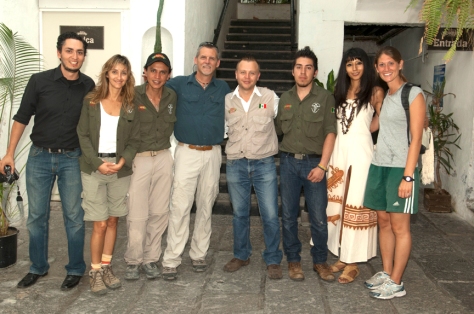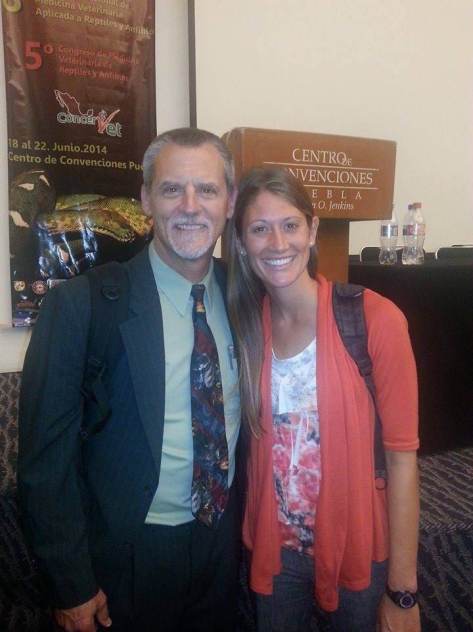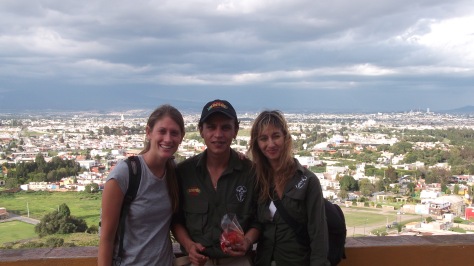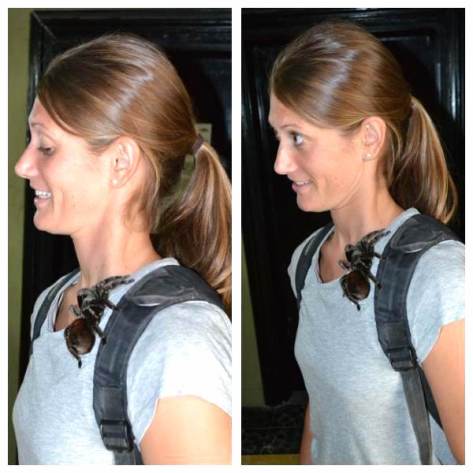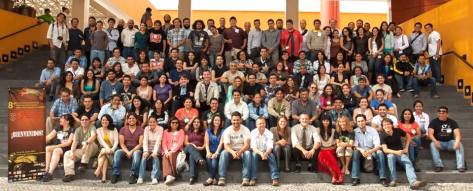Andrew Rossi had his fair share of plastic dinosaurs growing up. Like many kids, he dreamt of fossil digs and seeing T-rex in the flesh from a safe and secure distance. While Andrew went on to follow those childhood dreams, he also discovered many other passions along the way.
The beauty of writing is that it can be done anywhere at any time. -Andrew Rossi
It was comedy that brought Andrew and I together. We met in college at Ohio Wesleyan University. Similar to David Reitan, the other “funny guy” I interviewed, Andrew and I were members of OWU’s Babbling Bishops Improv Comedy Troupe. While we were not in the troupe at the same time, we have had our fair share of moments improvising together on-stage. One thing about the Babbling Bishops: any and all of us are family for life.
I live each day knowing the greatest accomplishments of my life are still ahead of me. -Andrew Rossi
A Euclid, OH native and 2013 Geology and Theatre graduate of OWU, Andrew now lives in the beautiful mountain west boonies. He works at the Wyoming Dinosaur Center, where he is actively combining his acting prowess and scientific knowledge. When Pixar’s “The Good Dinosaur” came out, the cinematic crew wanted to have an exclusive interview with a geology professional. With Andrew’s theatre background, he was the perfect candidate.
The real world is chaotic; try as you might, you’ll never be able to anticipate everything, or even most things. -Andrew Rossi
In the DVD extra of “The Good Dinosaur,” you can catch Andrew’s impressive, educational and, as always, entertaining video talking about all things dinosaur.
I’ll light my candle from the flame, and spread it as far as I can. -Andrew Rossi
After watching the video, I learned from Andrew that it was all on the spot improv due to a glitch. As an actor, I know all too well about the mishaps that go on behind the scenes.

Those setbacks often create the most memorable on-screen moments. And Andrew pulled it off like a champ! But really, I’m not surprised. He is David Attenborough reincarnated.
I like being spontaneous, and at times I’d rather see a group or institution share more glory than myself. -Andrew Rossi
I think one of the reasons Andrew and I have reconnected of late is because we have a lot of similarities. We are both chasing our dreams and merging our passions–which also happen to be the same: science, acting and writing! Plus, the man makes me laugh and inspires me on the daily.
The world needs scientists; it needs experts to learn more about their fields and increase our understanding of our dynamic world. -Andrew Rossi
We can all learn a thing or two from this brilliant and hilarious man. Check out the interview below for some insight (and chuckles) into the life of Andrew Rossi.
S: What is your most rewarding accomplishment?
A: Only one? No singular accomplishment comes to mind. I live each day knowing the greatest accomplishments of my life are still ahead of me. There are certainly big ones that immediately pop up–the Pixar interview, graduating college, having the job I’ve always dreamed of. But there are smaller ones that give me just as much pride, like being best man at my friend’s wedding, a friend I’ve known since I was twelve years old. I feel it’s the small, intimate moments that make the greatest impacts on our lives. Too profound to start?

S: You work with fossils which is like, woah, super cool. A lot of kids dream of doing that. Have you been on a path towards working with fossils since childhood or what sparked your interest?
A: Yes and no. I’ve been into dinosaurs since before I can remember; it was my second or third word as a toddler. And I eagerly read or watched everything dinosaur-related I could get my hands on as I was growing up. I suppose it has been a fairly linear path, but one with a lot of diversions and more than a few doubts. I don’t know what caused the spark, but that spark lit a fire that’s only gotten stronger as time has gone by.
S: You are an alumnus of the Babbling Bishops, Ohio Wesleyan University’s improv comedy troupe. How did college improv prepare you for “the real world?”
A: The real world is chaotic; try as you might, you’ll never be able to anticipate everything, or even most things. Or some of the things. I’ve always lived in the moment, to my benefit and detriment. Thanks to improv, I am a lot more comfortable with chaos.
A lot of people tend to buckle under pressure, especially when they’ve developed a plan to get them through it. But that goes against every doctrine of improv. You have to let go and trust that you’ll get by. It’s not easy, and there’s always the latent desire to plan. But to no avail! Once you accept the fact that nothing is controllable and you let your mind roam freely and spontaneously, you become better. And you get funnier!
But improv isn’t a personal pedestal either; it’s all about the group dynamic. Good improv troupes work well as a single entity, rather than a collection of personalities. You can bring your personal quirks and talents to the troupe, by all means! But personal showboating makes everyone look bad. You rise and fall based on the strengths of everyone around you, and how they–and you–support everyone else. Again, not an easy lesson to learn, but one of the most important things to learn, regardless of where you go.
I like being spontaneous, and at times I’d rather see a group or institution share more glory than myself. I learned these things with the Babblers; easily one of the best things that’s ever happened to me. And it was so damn fun too! So, three things I learned, actually: spontaneity, selflessness, and just having a good time with incredible people.
S: Your interview for “The Good Dinosaur” combines your degrees in theatre and science. And, cool beans, it features you and only you! How did this opportunity come about? What was your reaction when you found out about it?
A: Well, so much for the selflessness . . .
The Good Dinosaur was a dinosaur movie (GASP!) based on the landscapes of Wyoming. The State of Wyoming wanted to capitalize on the movie as part of their new ad campaign: That’s WY! So when they wanted to talk about dinosaurs in Wyoming, there was really only one place to go. (That would be the Wyoming Dinosaur Center, where I work.) That’s when they reached out to my boss for an interview. She was out of town on those dates, but by this point she knew I was not only capable of being a “personality” in front of a camera, but that I would professionally represent our museum. My initial reaction wasn’t one of immense pride or joy, but not nervousness either. I was definitely excited to be a minor DVD extra celebrity, but I immediately planned to use the interview as a platform to show the world how great the WDC is and what kind of opportunities we offer for kids and adults to partake in the world of paleontology.

S: What was it like working with the Pixar crew?
A: Quick and painless. They arrived with a convoy of vans and trucks, full of camera equipment and an army of technicians. This is where the improv training REALLY comes into its own. A few pages of questions sent a week before the filming failed to reach me, so the entire interview was unrehearsed and unplanned. I had only a few seconds to process each question and provide a detailed, informative, and–yes–entertaining answer. And, thanks to my background in theatre and improv and their editing skills, it sounds pretty well-rehearsed and coherent. They were thrilled and relieved to work with someone with a background in theatre, as it made all of our jobs easier.
All in all, I had a great time doing it and they had a great time filming it . . . although I wish I had said “impressions” instead of “suppressions” . . . I totally did. Go watch the interview again, when I’m talking about the dinosaur trackway. Suppressions in the mud? The footprints aren’t suppressing anything!
S: Do you think you’ll seek out more film/stage gigs or will you kind of just check them out if something good comes along?
A: Hmm, that’s tricky. I would definitely like to try my hand at professional acting someday, since I know I’ll regret not trying while I’m still young. There’s a lot of uncertainty in my future, which I know is true for most people our age. A lot of opportunities have presented themselves, in a bunch of different areas–all I have to decide is where to go, and it isn’t easy. The reassuring fact is that I know I’ll succeed, wherever I choose to go. It’s not so much a confidence in my talents as it is knowing that I’ll give it my all. In the meantime, I get my theatrical kicks by writing . . . not dancing, despite the use of the word “kicks.” (I’m as graceful as a hippopotamus on roller blades.)

I discovered playwriting in college, and I’ve been very fortunate to have a lot of plays performed as an undergraduate. The beauty of writing is that it can be done anywhere at any time, so it gives me a more ludicrously creative output to channel my theatricality.
UPDATE: Andrew can be seen online hosting Fossil Fridays live at the Wyoming Dinosaur Center.
ANOTHER UPDATE: Andrew will be Lumiere in Cody Community Theatre’s production of “Beauty and the Beast.” I can’t think of a role more fitting!
S: It seems like your heart is in more than once place, science and theatre. I think a lot of people can relate to that, but perhaps feel like society forces us to choose one career path and nurture it for the rest of our lives. Do you have an opinion on that? Do you think it’s important to remain well-rounded or would you rather become an expert in one field?
A: Yes.
Okay, serious time.
I don’t know if I’ll ever become a full-fledged paleontologist (aka get a Ph.D.). To tell the truth, I’ve always had difficulty with “hard science.” Writing papers, doing research . . . it’s all very tedious, and I struggle. It was heartbreaking to finally realize this about myself, as it was my aspiration since I was a child.
But I know science, and I know paleontology! I also know theatre. Then came the epiphany: I can teach, I can interpret, and I can inspire! Now, it’s what I do on a daily basis. I know dinosaurs, but I can also communicate dinosaurs, in ways that simultaneously entertain and educate. It seems trivial, but being able to speak with crowds is a skill a lot of scientists either fear or deliberately avoid.

The world needs scientists; it needs experts to learn more about their fields and increase our understanding of our dynamic world. But our world also needs to engage in and share science, and somebody has to light the sparks of future scientists. And with the current climate of our world (pun somewhat intended), we need communication more than ever before. I will probably write peer-reviewed papers and give technical talks in the future–no doubt–but I don’t think I’ll discover the next new species of dinosaur – but I’ll tell its story, and the story of the scientists who found it. And I’ll do whatever I can to make the world understand “this matters.”
And now I have the opportunity of a lifetime to make that happen. The Wyoming Dinosaur Center is planning a major expansion in the next few years. Tripling our exhibit space, re-imaging our programs and mission, trying to create a world-class museum that encourages hands-on learning and unforgettable experiences.
Because of my background, my passion, and my imagination, I am one of the visionaries of this project: I get to build the dinosaur museum I’ve always dreamed about. This comes hand in hand with becoming the public face of our new vision; when the world wants to know more about the Wyoming Dinosaur Center, they come to me. And that’s when the work really begins. This might be my biggest mark in the world. It’s daunting. I can’t wait to show the world what we’re planning.
I’m not aspiring to be the torchbearer; I’ll light my candle from the flame, and spread it as far as I can.
Now reread this entire statement in Neil Degrasse Tyson’s voice. It’s that much more epic.
S: What do you do in your free time?
A: Free time?
That’s all I got.
Thank you, Andrew, for your insight, comedy and honesty. And for reminding us all that science is vital to the betterment of this world’s future.
All photos via Andrew Rossi, aka Sir David Attenborough (reincarnated).









